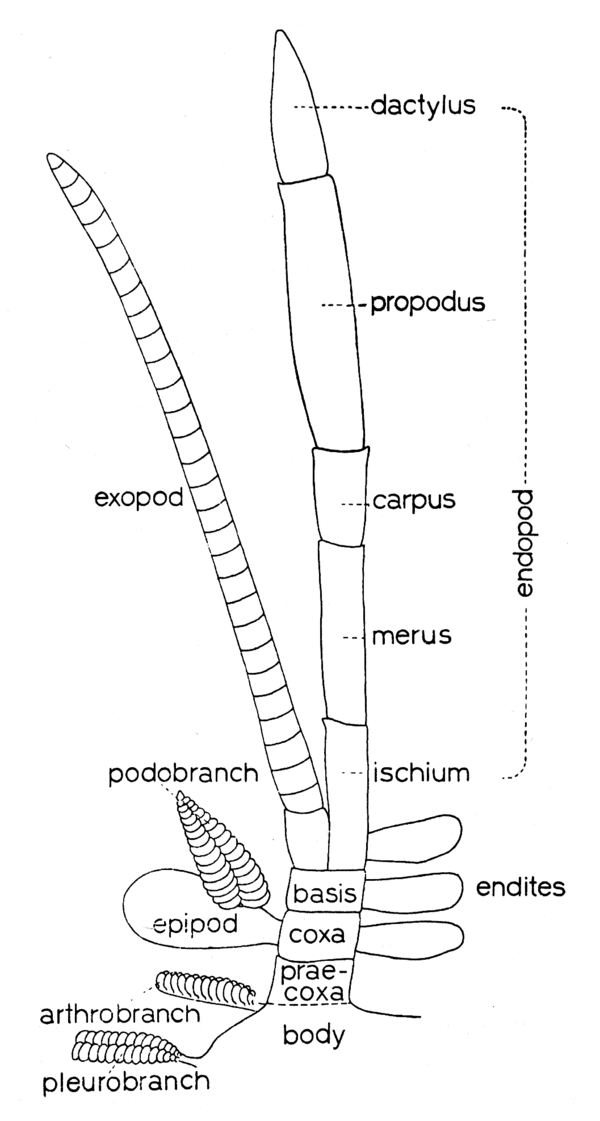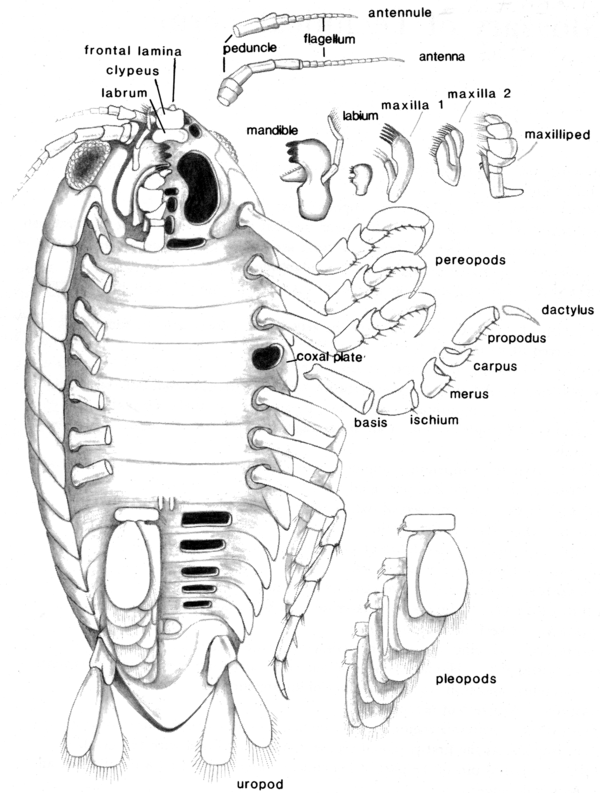- coxa
- (
 ) [Holthuis, 1993].Schematic drawing of a thoracic leg. [Holthuis, 1993]Article 1 of thoracic and abdominal appendages [Holdich and Jones, 1983].First article of limb, usually short [Poore, 2004].First or proximal article of leg or maxilliped. (Syn. coxopodite) [Williams, 1984].First or proximal podomere of a typically 7-segmented appendage (Fig. 3C). (Pl. coxae) [Perez Farfante and Kensley, 1997].First or proximal segment of a typically 7-segmented apendage. (Pl. coxae) [Butler, T.H.].Proximal (first) segment of segmented appendage [Hobbs and Jass, 1988].Segment of appendage adjoining sternite, except in forms having precoxa. (Syn. coxopodite) [McLaughlin, 1980].Segment of limb directly attached to sternite of body (except rarely in forms having distinguishable precoxal segment). (Syn. coxopod(ite)) [Moore and McCormick, 1969].Seventh segment of a pereiopod, counted from the distal end [Ingle, 1983].The basal podomere of a limb (Fig. 1) [Warner, 1977].The first (proximal) segment of a segmented appendage [Hobbs, Hobbs, and Daniel 1977].The first or basal segment of a thoracic appendage. See: pereopod [Wilson, 1989].The first or proximal segment of a typically 7-segmented appendage. (Pl. coxae) [Chace and Hobbs, 1969].(Class Cephalocarida):Protopod [Stachowitsch, 1992].(Order Cumacea):First segment of thoracopod (maxillipeds and pereopods) or pleopod. May be more or less fused with ventral surface (sternites) of body. Coxae of second maxillipeds fused to one another. (Syn. coxopodite) [Stachowitsch, 1992].(Order Tanaidacea):First of seven segments (coxa, basis, ischium, mercus, carpus, propodus, dactylus) of thoracopod. Bears well-developed epipod in maxillipeds (= first thoracopods) and may be indistinct or absent in chelipeds (= second thoracopods). (Syn. coxopodite) See: precoxa [Stachowitsch, 1992].(Order Decapoda):First, most proximal segment of appendage; forms protopod together with following segment (basis). Depending on appendage, coxa may bear opening of antennal gland, epipodite, gill (podobranch), or gonopore. (Syn. coxopodite) [Stachowitsch, 1992].(Order Amphipoda):First of basically seven segments (coxa, basis, ischium, merus, carpus, propodus, dactylus) of thoracopod; typically developed as large, immovable coxal plate. (Syn. coxapodite) [Stachowitsch, 1992].(Order Isopoda):Basal article of an appendage, attached to sternite, sometimes expanded into a lateral coxal plate [Kensley and Schotte, 1989].(
) [Holthuis, 1993].Schematic drawing of a thoracic leg. [Holthuis, 1993]Article 1 of thoracic and abdominal appendages [Holdich and Jones, 1983].First article of limb, usually short [Poore, 2004].First or proximal article of leg or maxilliped. (Syn. coxopodite) [Williams, 1984].First or proximal podomere of a typically 7-segmented appendage (Fig. 3C). (Pl. coxae) [Perez Farfante and Kensley, 1997].First or proximal segment of a typically 7-segmented apendage. (Pl. coxae) [Butler, T.H.].Proximal (first) segment of segmented appendage [Hobbs and Jass, 1988].Segment of appendage adjoining sternite, except in forms having precoxa. (Syn. coxopodite) [McLaughlin, 1980].Segment of limb directly attached to sternite of body (except rarely in forms having distinguishable precoxal segment). (Syn. coxopod(ite)) [Moore and McCormick, 1969].Seventh segment of a pereiopod, counted from the distal end [Ingle, 1983].The basal podomere of a limb (Fig. 1) [Warner, 1977].The first (proximal) segment of a segmented appendage [Hobbs, Hobbs, and Daniel 1977].The first or basal segment of a thoracic appendage. See: pereopod [Wilson, 1989].The first or proximal segment of a typically 7-segmented appendage. (Pl. coxae) [Chace and Hobbs, 1969].(Class Cephalocarida):Protopod [Stachowitsch, 1992].(Order Cumacea):First segment of thoracopod (maxillipeds and pereopods) or pleopod. May be more or less fused with ventral surface (sternites) of body. Coxae of second maxillipeds fused to one another. (Syn. coxopodite) [Stachowitsch, 1992].(Order Tanaidacea):First of seven segments (coxa, basis, ischium, mercus, carpus, propodus, dactylus) of thoracopod. Bears well-developed epipod in maxillipeds (= first thoracopods) and may be indistinct or absent in chelipeds (= second thoracopods). (Syn. coxopodite) See: precoxa [Stachowitsch, 1992].(Order Decapoda):First, most proximal segment of appendage; forms protopod together with following segment (basis). Depending on appendage, coxa may bear opening of antennal gland, epipodite, gill (podobranch), or gonopore. (Syn. coxopodite) [Stachowitsch, 1992].(Order Amphipoda):First of basically seven segments (coxa, basis, ischium, merus, carpus, propodus, dactylus) of thoracopod; typically developed as large, immovable coxal plate. (Syn. coxapodite) [Stachowitsch, 1992].(Order Isopoda):Basal article of an appendage, attached to sternite, sometimes expanded into a lateral coxal plate [Kensley and Schotte, 1989].( )Schematic representation of an isopod illustrating morphological terms. [Kensley and Schotte, 1989](Order Isopoda):Basal article of an appendage [Wetzer et al. 1997].(
)Schematic representation of an isopod illustrating morphological terms. [Kensley and Schotte, 1989](Order Isopoda):Basal article of an appendage [Wetzer et al. 1997].( )Nomenclature of isopod cephalon (A). Examples of isopod mouth appendages: Idoteidae (B, C, F, H); Cirolanidae (D, E, G, I). [Wetzer et al. 1997](Order Isopoda):First segment of pereopod; often expanded to form projecting coxal plate. (Syn. coxapodite) [Stachowitsch, 1992].(Order Mysida):First of two segments (coxa, basis) of proximal part (protopod) of appendage. (Syn. coxopodite) [Stachowitsch, 1992].(Order Stomatopoda):Second segment of thoracic appendage (thoracopod). Also interpreted as being first segment (forming fused precoxa and coxa). (Syn. coxopodite) [Stachowitsch, 1992].(Order Leptostraca):Most proximal segment of appendage. Gonopores located on coxae of sixth (female) or eighth (male) thoracopods [Stachowitsch, 1992].(Subclass Branchiura):In thoracopod, second of three segments (precoxa, coax, basis) of protopod; may also be applied to segment of antennule. (Syn. coxopodite) [Stachowitsch, 1992].(Subclass Copepoda):First, most proximal segment of appendage. Typically forms protopod together with following segment (basis). Generally specified only in maxillules (where it bears endites and exites) and pereopods (coxae of opposed limbs united). (Syn. coxopodite) [Stachowitsch, 1992].(Subclass Copepoda):The middle segment of the 3-segmented protopod of postmandibular limbs, the proximal segment of the 2-segmented protopod of the antenna and mandible [Boxshall and Halsey, 2004].(Subclass Copepoda):The middle segment of the protopod, proximal to the basis and distal to the praecoxa, with a single setose endite; the mandibular gnathobase of copepods includes the coxal endite with its single seta (see basis and praecoxa) [Ferrari and Dahms, in press].(Subclass Mystacocarida):Protopod [Stachowitsch, 1992].(Class Ostracoda):First, most proximal segment of appendage; typically forms protopod together with following segment (basis). Forms ganthobase in mandibles. (See also precoxa). (Syn. coxopodite) [Stachowitsch, 1992].(Class Ostracoda):Proximal part of divided protopod (separated from basis by suture). See: protopod [Cohen, Peterson, and Maddocks, in press].(Superorder Syncarida):First of two segments (coxa, basis) of proximal part (protopod) of appendage. May bear lateral lobes (endites, epipods). (Syn. coxopodite) [Stachowitsch, 1992].(Order Thermosbaenacea):First of two segments (coxa, basis) of proximal part (protopod) of appendage. (Syn. coxopodite) [Stachowitsch, 1992].(Order Euphausiacea):First, most proximal segment of appendage; forms protopod together with following segment (basis). Typically specified only when referring to thoracopods. Coxae of maxillae bear endites, those of thoracopods bear gills (epipodites), with coxae of second and seventh thoracopods (occasionally more) containing photophores. (Syn. coxapodite) [Stachowitsch, 1992].
)Nomenclature of isopod cephalon (A). Examples of isopod mouth appendages: Idoteidae (B, C, F, H); Cirolanidae (D, E, G, I). [Wetzer et al. 1997](Order Isopoda):First segment of pereopod; often expanded to form projecting coxal plate. (Syn. coxapodite) [Stachowitsch, 1992].(Order Mysida):First of two segments (coxa, basis) of proximal part (protopod) of appendage. (Syn. coxopodite) [Stachowitsch, 1992].(Order Stomatopoda):Second segment of thoracic appendage (thoracopod). Also interpreted as being first segment (forming fused precoxa and coxa). (Syn. coxopodite) [Stachowitsch, 1992].(Order Leptostraca):Most proximal segment of appendage. Gonopores located on coxae of sixth (female) or eighth (male) thoracopods [Stachowitsch, 1992].(Subclass Branchiura):In thoracopod, second of three segments (precoxa, coax, basis) of protopod; may also be applied to segment of antennule. (Syn. coxopodite) [Stachowitsch, 1992].(Subclass Copepoda):First, most proximal segment of appendage. Typically forms protopod together with following segment (basis). Generally specified only in maxillules (where it bears endites and exites) and pereopods (coxae of opposed limbs united). (Syn. coxopodite) [Stachowitsch, 1992].(Subclass Copepoda):The middle segment of the 3-segmented protopod of postmandibular limbs, the proximal segment of the 2-segmented protopod of the antenna and mandible [Boxshall and Halsey, 2004].(Subclass Copepoda):The middle segment of the protopod, proximal to the basis and distal to the praecoxa, with a single setose endite; the mandibular gnathobase of copepods includes the coxal endite with its single seta (see basis and praecoxa) [Ferrari and Dahms, in press].(Subclass Mystacocarida):Protopod [Stachowitsch, 1992].(Class Ostracoda):First, most proximal segment of appendage; typically forms protopod together with following segment (basis). Forms ganthobase in mandibles. (See also precoxa). (Syn. coxopodite) [Stachowitsch, 1992].(Class Ostracoda):Proximal part of divided protopod (separated from basis by suture). See: protopod [Cohen, Peterson, and Maddocks, in press].(Superorder Syncarida):First of two segments (coxa, basis) of proximal part (protopod) of appendage. May bear lateral lobes (endites, epipods). (Syn. coxopodite) [Stachowitsch, 1992].(Order Thermosbaenacea):First of two segments (coxa, basis) of proximal part (protopod) of appendage. (Syn. coxopodite) [Stachowitsch, 1992].(Order Euphausiacea):First, most proximal segment of appendage; forms protopod together with following segment (basis). Typically specified only when referring to thoracopods. Coxae of maxillae bear endites, those of thoracopods bear gills (epipodites), with coxae of second and seventh thoracopods (occasionally more) containing photophores. (Syn. coxapodite) [Stachowitsch, 1992].
Crustacea glossary. Natural History Museum of Los Angeles County. 2011.
